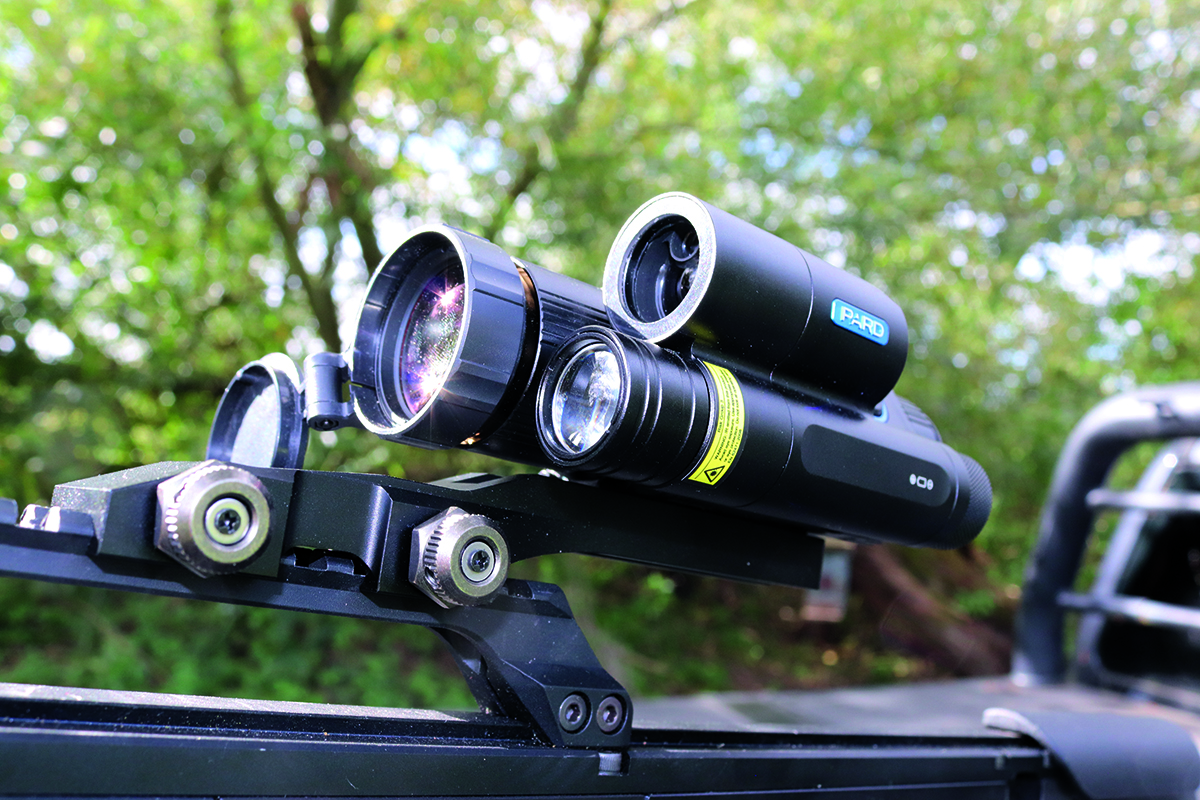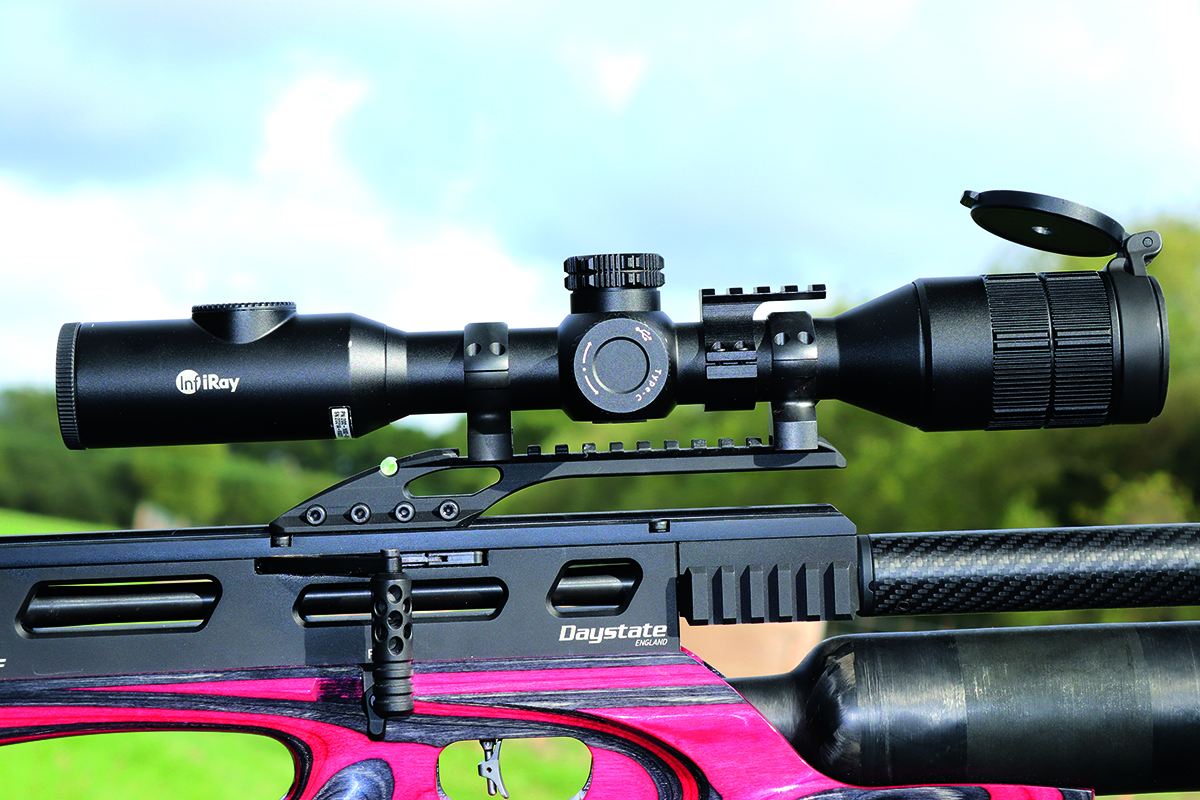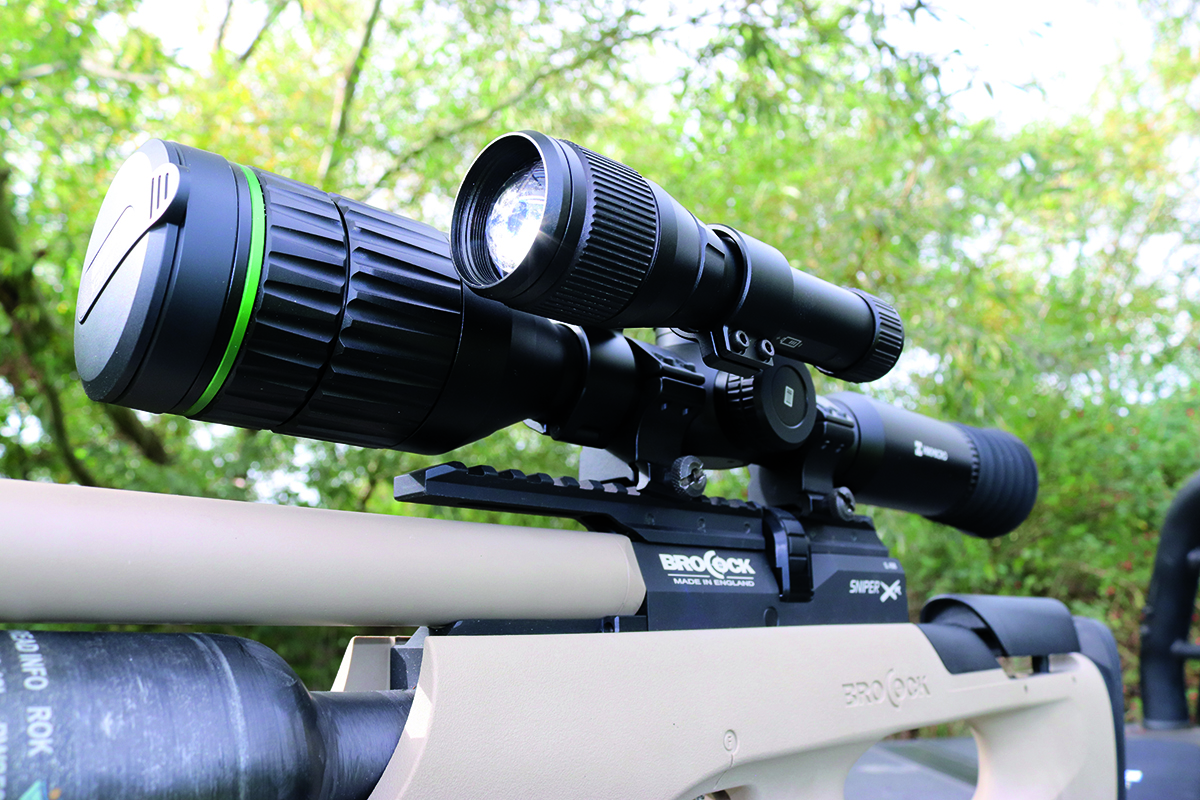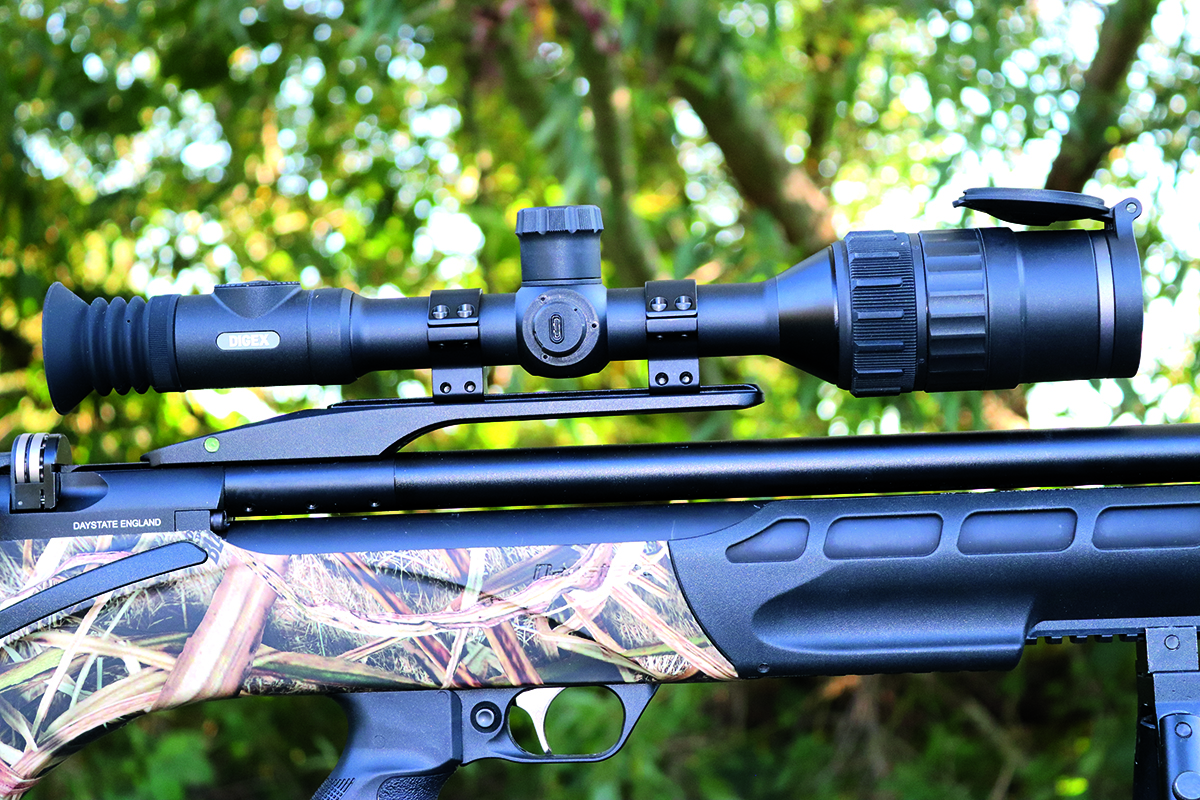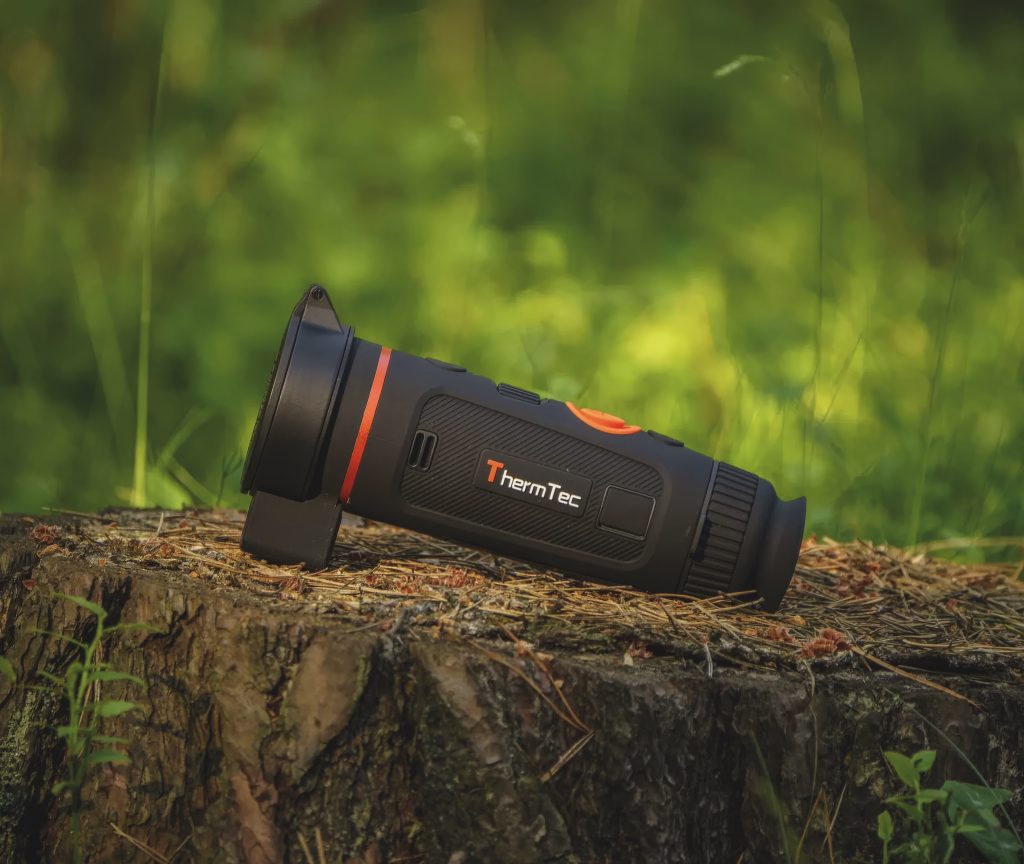Win CENS ProFlex DX5 earplugs worth £1,149 – enter here
Best infrared scopes – our top picks
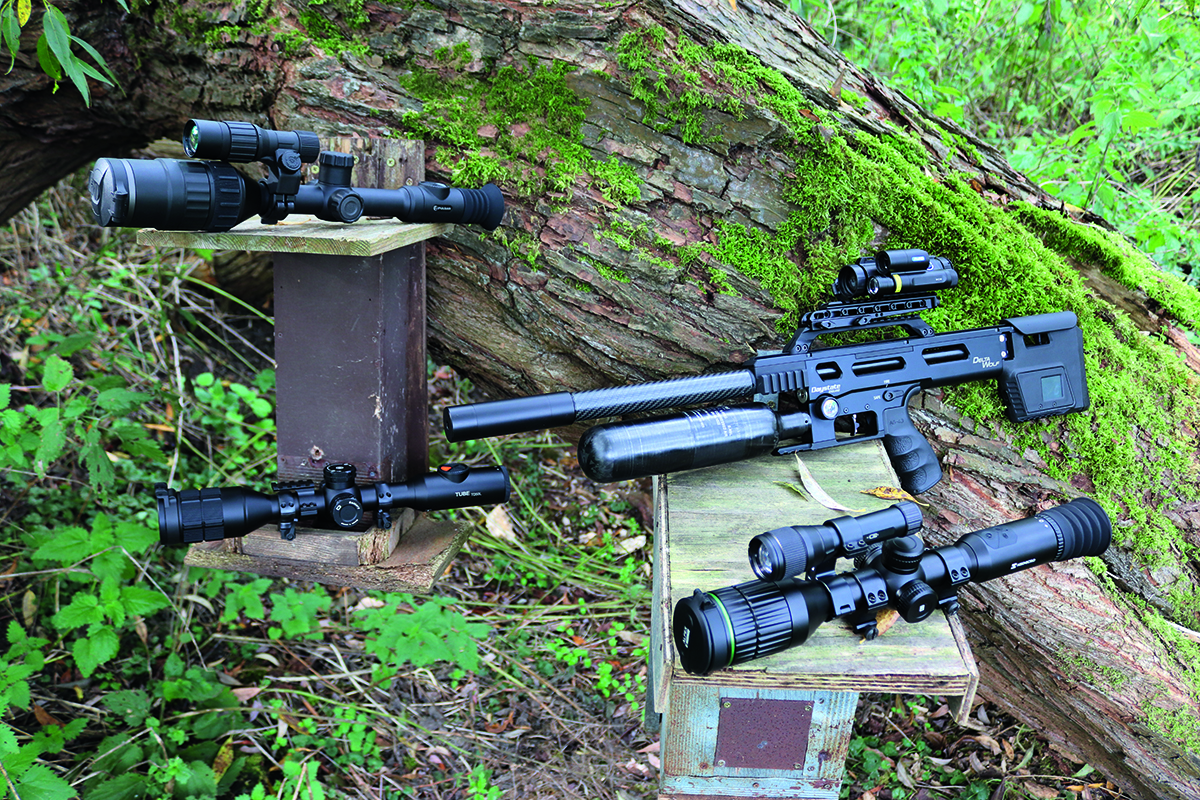
The long summer heatwave is finally history and the clocks have gone back. But cheer up, hunters – that means the nights are once more longer, and despite what you might think this is the perfect time to get outside and take on the challenge of hunting rabbits and dealing with rats.
Unfortunately, it’s not always that straightforward though because you’re going to need some specialist equipment. The time-honoured lamping still works of course, but has become less popular in the face of new technology. For those with the deepest pockets, thermal scopes are perhaps the ultimate night vision (NV) option, but are maybe a little overkill for short-range airgun use.
And at the other end of the fiscal scale, the IR products that attach to the back of a conventional day scope tick many boxes, especially when it comes to short-range ratting. But somewhere in the middle, digital infrared (IR) day/night scopes have become something of a battleground for manufacturers vying for our attention and wallets. ATN, Pulsar and Yukon deserve much of the credit for building the category. However, in recent years their dominance has been challenged by a series of new market entrants. So we’re thinking about the best infrared scopes on the market right now.
Far from sitting back and letting the new kids have their run of the block, Pulsar has continued to innovate and we’ll be looking at its recently launched Digex C50 (£1,239.95) thanks to UK distributor Thomas Jacks. Pard was one of the first to disrupt the established IR order and we have the NV008S LRF (£899.99) to put through its paces courtesy of The Sportsman Gun Centre.
Night vision specialist Scott Country International has been at the forefront when it comes to bringing us new products. Thanks to them we’re including the HikMicro Alpex A50 T (£799.99) and InfiRay Tube TD50L (£899.95).
Best infrared scopes – our top picks
Pard NV008S LRF
Price as reviewed: £899.99
Pard is what young types in smart suits call a “market disrupter”. In other words, when its products, principally the NV007 and NV008, were first made available to airgunners we lapped them up and suddenly the IR establishment had a fight on its hands.
Fast forward a few years and Pard is now part of that establishment, defending its market share against the old guard that have fought back as well as new upstarts. Its latest product, the NV008S LRF, has upped the ante once again.
Like its predecessor, the new product is compact and light at just 182mm long and weighing 445g. The non-rangefinder version, which retails for £645.99, is lighter still. Yet despite its diminutive proportions, the NV008S LRF complements its rangefinder with an integrated adjustable 850nm IR illuminator, unlike competitive products that require a separate torch attachment.
The LRF version may cost a bit more, but I’d suggest the outlay is worth it. Unlike fiddly stadiametric alternatives that require a target to be framed within a couple of cursors before an algorithm throws up a reading, the press of a button on the Pard indicates target distance.
That’s useful enough, but press the same button again and the ballistic calculator function will indicate how much holdover or under you need to apply by placing a cross on the reticle’s vertical axis. Setting up the function by means entering some data – pellet speed and ballistic coefficient, zero distance and the gap between the middle of the scope and middle of your barrel for example – takes only a minute or two, and it has five profiles, so you can save multiple setups.
It’s also worth mentioning the NV008S LRF Picatinny mounting system, which is reassuringly chunky, and the reach-back design enables perfect eye relief.
- Read here for Rich Saunders’ field test of the Pard NV008S LRF
InfiRay Tube TD50L
Price as reviewed: £899.95
It used to be that night vision scopes were boxy things. That’s changed now as many of the new crop of products are designed to resemble traditional glass scopes.
The InfiRay TD50L is a case in point. At 1.3kg and 400mm long it could pass as a large, 50mm objective lens, 30mm tube glass optic with conventional focus and dioptre adjustment. In fact, the only giveaways are the four buttons on the ocular bell. An orange power button switches it on and off, and activates a standby. One scrolls through five levels of brightness and operates the 1280×960 photo/video function, and the third allows you to select a colour day setting or monochrome IR night mode for use with the provided 850nm IR illuminator.
The 1280×960 LCOS display coupled with the image quality via the 1440×1080 CMOS, 50Hz frame sensor on the TD50L is still a compromise on top quality glass, but only just. And what is more, the use of a specially designed image algorithm delivers a crisp colour image without an IR torch in close-to-dark, pre-dawn and twilight conditions.
The top turret controls the 4-16x magnification function. A short press accesses a menu that will allow you to cycle through six different reticles in four colours. A long press brings up a more detailed menu that includes the one-shot zero function with three profiles as well as brightness and contrast settings and a picture-in-picture mode.
The right-hand turret houses a USB type C port to charge the internal battery and download footage and photos from the onboard 16GB memory. The left-hand turret houses an auxiliary 18500 battery (not supplied) to extend operation to a claimed 16 hours.
Read here for Mat Manning’s field test of the InfiRay Tube TD50L
HikMicro Alpex A50T
Price as reviewed: £799.99
The Alpex A50T looks like a conventional scope and shares the same 30mm chassis as HikMicro’s Stellar SH50 thermal scope. At 375mm, not including the rubber eyecup, it’s around the same length as a large glass scope, but a little heavier at 1.2kg.
Making complex technology easy is difficult, but HikMicro pulled it off. The left-hand turret accesses a magnification range of 3.5-14x. Pushing it shows a menu that includes plenty of functions, many of which you are only likely to set once.
Others, like the reticle choice (five in seven colours) and the one-shot zero function with five zero profiles, will be used occasionally. Some, such as the stadiametric rangefinder which I found too fiddly, will probably be ignored.
The functions you use constantly – picture-in-picture mode, day and night modes and taking photos or video – are controlled by two buttons located past the eyepiece. A third button switches the Alpex A50T on and off and operates an instant wake-up standby mode.
The 1024×768 HD OLED display is sharp and clear. And thanks to a 1920×1080 HD sensor that features an image defog algorithm, you can expect a crystal-clear view of the world right up to near-dark conditions that require only a glimmer of light from the stars or moon. When the sun is gone, a supplied 850nm IR illuminator attaches in seconds for a razor-sharp monochrome view of the world.
An internal battery is charged by unscrewing a cap on the right-hand turret to access a USB-C port, also used to download footage from the 64GB onboard memory. In addition, a CR123A 3v battery slots into the top turret. HikMicro says you can expect up to 13 hours of run time. You get two non-rechargeable CR123A batteries and two rechargeable 18650 batteries for the IR illuminator.
- The HikMicro features in Shooting Times 30 Christmas gift ideas
Pulsar Digger C50
Price as reviewed: £1,239.95
Having established the lookalike trend with its Thermion thermal optics, the Digex C50 is Pulsar’s first colour IR day/night scope. At just over 400mm and 1.1kg without mounts, it’s longer and heavier than glass, but comparable with other IR scopes.
The top of the range version comes with an X850S IR illuminator and wifi feature. Opting for a non-wifi version without a torch brings the cost down to £949.95. Standard though is an array of well thought out, top-performing features.
The 1928×1088 FHD CMOS sensor provides a crisp, bright image in all three modes via the 1024×768 AMOLED display. Yes, all three: a collar in front of the objective lens focus ring shows two settings with a sun and moon icon.
In ‘sun’ mode, the colour image is glass-rivalling sharp. When the sun fades and the image becomes grainy, the ‘moon’ mode uses remaining light to sharpen the colour image again. And a press on the power button activates the monochrome IR mode for when it’s properly dark.
Controls for the camera are to the right, and the button on the left turns on the 7x or 14x picture-in-picture function and operates the 3.5-14x digital zoom. A ring on the left-hand turret fine-tunes the zoom, whilst pushing a button gives you access to a menu for brightness, contrast and the rangefinder. A longer press opens a more detailed menu which includes a five-profile, one-shot zero function.
You get two APS2 batteries. One fits into the top turret and the second is used to power the IR illuminator. In addition, the CP50 has an internal battery charged via a USB-C port in the right-hand turret that is also used for data transfer. Pulsar says you can expect 8-10 hours of run time.
Related Articles
Get the latest news delivered direct to your door
Subscribe to Shooting Times & Country
Discover the ultimate companion for field sports enthusiasts with Shooting Times & Country Magazine, the UK’s leading weekly publication that has been at the forefront of shooting culture since 1882. Subscribers gain access to expert tips, comprehensive gear reviews, seasonal advice and a vibrant community of like-minded shooters.
Save on shop price when you subscribe with weekly issues featuring in-depth articles on gundog training, exclusive member offers and access to the digital back issue library. A Shooting Times & Country subscription is more than a magazine, don’t just read about the countryside; immerse yourself in its most authoritative and engaging publication.






